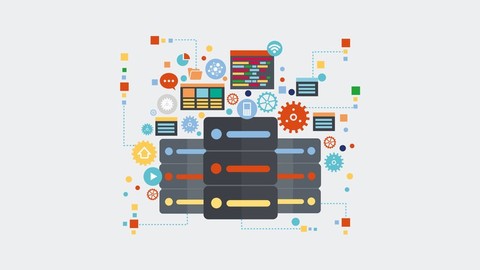
Apache Kylin : Implementing OLAP on the Hadoop platform
Apache Kylin : Implementing OLAP on the Hadoop platform, available at $49.99, has an average rating of 4.5, with 43 lectures, based on 187 reviews, and has 961 subscribers.
You will learn about Understand how OLAP Cube structures are created Build and query OLAP Cubes on Hadoop Big Data Platform Perform analytical queries on streaming data Integrate your big data cube with external tools or application Secure your OLAP Cube on the cluster This course is ideal for individuals who are Data Analysts or Big Data/Hadoop Data Engineers or Data Architects or Anyone who wants to be able to perform a complex aggregate/OLAP queries on large dataset. It is particularly useful for Data Analysts or Big Data/Hadoop Data Engineers or Data Architects or Anyone who wants to be able to perform a complex aggregate/OLAP queries on large dataset.
Enroll now: Apache Kylin : Implementing OLAP on the Hadoop platform
Summary
Title: Apache Kylin : Implementing OLAP on the Hadoop platform
Price: $49.99
Average Rating: 4.5
Number of Lectures: 43
Number of Published Lectures: 43
Number of Curriculum Items: 43
Number of Published Curriculum Objects: 43
Original Price: $19.99
Quality Status: approved
Status: Live
What You Will Learn
- Understand how OLAP Cube structures are created
- Build and query OLAP Cubes on Hadoop Big Data Platform
- Perform analytical queries on streaming data
- Integrate your big data cube with external tools or application
- Secure your OLAP Cube on the cluster
Who Should Attend
- Data Analysts
- Big Data/Hadoop Data Engineers
- Data Architects
- Anyone who wants to be able to perform a complex aggregate/OLAP queries on large dataset.
Target Audiences
- Data Analysts
- Big Data/Hadoop Data Engineers
- Data Architects
- Anyone who wants to be able to perform a complex aggregate/OLAP queries on large dataset.
A Comprehensive Course for Learning How to Build and Query Big Data OLAP Cubes Using Apache Kylin.
Apache Kylin is an Apache top-level project that bring OLAP to Big data. This simply means that we can now write complex aggregation queries with different levels of aggregation and expect to get a second or micro-seconds response to our query.�
Online analytical processing (OLAP) has been a common word in traditional business intelligence for years but has not been easy with hadoop platform that has become a data lake solution for many. These data lake often have hundreds of millions and even billions of records that organizations want to slice and dice for insights. However, the high latency of query execution in SQL on Hadoop technologies like Apache Hive or Apache Drill often meant that data architect opted to transfer their data back to traditional systems that allow for real time response to query.
Kylin solves all of this.�
With Apache Kylin, anyone with the skills can now build OLAP, ROLAP or MOLAP structures using a web UI, deploy it and expect to query these structure with second of response time in mind. Also, one can connect their applications or favorite visualization tools to Kylin to integrate data either for system processing or for visualization.�
In this course, we are going to review�
- What Kylin is
- How it works
- How to build OLAP cubes in batch and streaming model
- How to deploy the cubes
- How to query cubes
- How to connect external tools and applications to Kylin
.. and many more
What is the target audience?
Big Data Engineers/Developers
Data Architects
Data Analysts.
Anyone who wishes to be able to write simple to complex aggregation queries of large dataset and wants a low latency response time.
What are the requirements?
You need access to a Big Data Sandbox like Cloudera quickstart VM, Hortonworks HDP sandbox or a cloud-based Hadoop environment with a least 10GB of Ram.
You should have some familiarity SQL and be able to use ODBC or JDBC based tools.
Some familiarity with Linux will be helpful
What do I need to know to get the best out of this course?
Because Kylin uses other hadoop projects to achieve its design a fair understanding of projects like Apache Hive, Apache Kafka, Apache HBase, MapReduce is great for this course. However, one can still use Kylin without any knowledge of these technologies.�
It is also worth knowing that no prior knowledge of any big data technology is required to query Kylin or use data integration in running report or data visualizations.
Course Curriculum
Chapter 1: Course Introduction
Lecture 1: Introduction
Lecture 2: What is Kylin?
Lecture 3: How Kylin Works. I
Lecture 4: How Kylin Works. II
Lecture 5: How Kylin Works. III
Lecture 6: Installing Kylin in Hortonworks HDP Sandbox
Lecture 7: Installing Kylin in Cloudera CDH Sandbox
Lecture 8: Installing Kylin in a Custom Hadoop Environment
Lecture 9: Our First Taste of a Kylin Cube
Lecture 10: Exploring the web console
Lecture 11: Resources
Chapter 2: Use Case 1: AdventureWorks DW
Lecture 1: Introduction to AdventureWorks DW Dataset
Lecture 2: AdventureWorks Dataset Preparation
Lecture 3: Create Your Data Sources
Lecture 4: Implementing The Data Model
Lecture 5: Create The Cube
Lecture 6: Building The Cube
Lecture 7: Querying the Cube
Lecture 8: Troubleshooting tips
Chapter 3: Use Case 2: Analyzing Flight Delays
Lecture 1: Introduction to Airline on-time performance Dataset
Lecture 2: Dataset Preparation
Lecture 3: Incremental Build
Lecture 4: Running Incremental Cube Building
Lecture 5: Single Fact/Dimension Table Model
Lecture 6: Cube Optimization/Tuning I
Lecture 7: Cube Optimization/Tuning II
Lecture 8: Summary
Chapter 4: Use Case 3: Access Log Files
Lecture 1: Introduction the Use case
Lecture 2: How Kylin with Streaming Tables work?
Lecture 3: Data Preparation & Kafka Setup
Lecture 4: Implementing OLAP Cube Over Streaming Dataset in Kafka
Lecture 5: Building The Cube With Streaming Logs
Lecture 6: Query the Cube
Lecture 7: Troubleshooting
Chapter 5: Kylin Client Integration
Lecture 1: Introduction to Kylin Client Integration
Lecture 2: Rest API Integration
Lecture 3: ODBC Integration (MS Excel)
Lecture 4: JDBC Integration (Sample Java application)
Lecture 5: Integrate with Apache Zeppelin
Chapter 6: Other Features
Lecture 1: Query Routing
Lecture 2: Security
Lecture 3: Storage Cleanup
Chapter 7: Conclusion
Lecture 1: Final Words
Instructors
-
Michael Enudi
Okmich
Rating Distribution
- 1 stars: 7 votes
- 2 stars: 7 votes
- 3 stars: 26 votes
- 4 stars: 69 votes
- 5 stars: 78 votes
Frequently Asked Questions
How long do I have access to the course materials?
You can view and review the lecture materials indefinitely, like an on-demand channel.
Can I take my courses with me wherever I go?
Definitely! If you have an internet connection, courses on Udemy are available on any device at any time. If you don’t have an internet connection, some instructors also let their students download course lectures. That’s up to the instructor though, so make sure you get on their good side!
You may also like
- Best Yoga Instruction Courses to Learn in March 2025
- Best Stress Management Courses to Learn in March 2025
- Best Mindfulness Meditation Courses to Learn in March 2025
- Best Life Coaching Courses to Learn in March 2025
- Best Career Development Courses to Learn in March 2025
- Best Relationship Building Courses to Learn in March 2025
- Best Parenting Skills Courses to Learn in March 2025
- Best Home Improvement Courses to Learn in March 2025
- Best Gardening Courses to Learn in March 2025
- Best Sewing And Knitting Courses to Learn in March 2025
- Best Interior Design Courses to Learn in March 2025
- Best Writing Courses Courses to Learn in March 2025
- Best Storytelling Courses to Learn in March 2025
- Best Creativity Workshops Courses to Learn in March 2025
- Best Resilience Training Courses to Learn in March 2025
- Best Emotional Intelligence Courses to Learn in March 2025
- Best Time Management Courses to Learn in March 2025
- Best Remote Work Strategies Courses to Learn in March 2025
- Best Freelancing Courses to Learn in March 2025
- Best E-commerce Strategies Courses to Learn in March 2025






















